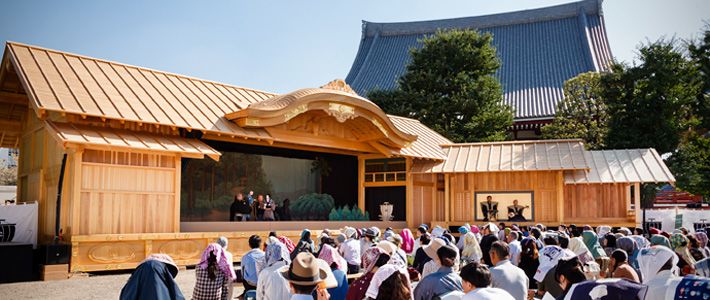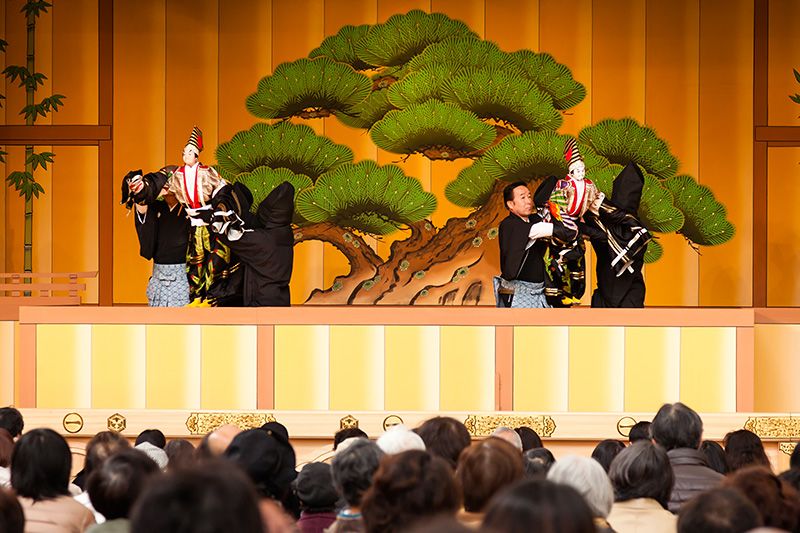
“Cool Traditions” Stay in Tune with Modern Life
Outdoor Performances Bring Bunraku Back to Its Popular Roots
Culture- English
- 日本語
- 简体字
- 繁體字
- Français
- Español
- العربية
- Русский
Reviving a Struggling Art
 Narrators and shamisen players at the Roppongi Hills performance.
Narrators and shamisen players at the Roppongi Hills performance.
Once Japan’s most popular performing art, bunraku puppet theater has struggled to find an audience in the twenty-first century. Each of the large puppets is controlled by three black-clad puppeteers—one moves the head and right hand, one the left hand, and one the feet—while narrators chant to the accompaniment of shamisen music. Although UNESCO added bunraku to its Representative List of the Intangible Cultural Heritage of Humanity in 2008, this did not revive its popular fortunes. In 2014, the art suffered a serious blow in its traditional home of Osaka when Mayor Hashimoto Tōru cut the city’s subsidies for the association of bunraku performers.
 Puppets in action at the Sensōji performance.
Puppets in action at the Sensōji performance.
To breathe new life into this artistic treasure, the Nippon Foundation launched the Nippon Bunraku project in 2015. So far, the project has held three successful performances bringing bunraku to new audiences. The first took place in March 2015 in Roppongi Hills, Tokyo; the second in October 2015 on the site of the former palace Naniwanomiya in Osaka; and the third in October 2016 at Sensōji temple (Asakusa Kannon) in Tokyo. The next performance is planned in March 2017 at Ise Shrine—dedicated to the sun goddess Amaterasu and one of the holiest Shintō sites.
 A long line to get into the theater forms before the first performance at Roppongi Hills.
A long line to get into the theater forms before the first performance at Roppongi Hills.
Returning to Roots as Casual Entertainment
The project is aimed at making bunraku a more casual and accessible event, where audiences can sit outside and eat and drink while watching. In the heyday of the art in the Edo period (1603–1868), common people would gather around simple, temporary stages within temple or shrine grounds or on riverbanks and enjoy meals during the performance. Today, however, bunraku plays typically take place at highbrow theaters built by the national government, which can be intimidating to the uninitiated.
At the project’s launch press conference, puppeteer Kiritake Kanjūrō III analyzed the decline in bunraku’s popularity as follows. “Bunraku was refined as an art through the generations, but perhaps this refinement made it more difficult to enjoy the plays as casual entertainment.”
 Kiritake Kanjūrō III at the Nippon Bunraku press preview at Hills Cafe, Roppongi Hills, in August 2014. Photograph by Ōsawa Hisayoshi.
Kiritake Kanjūrō III at the Nippon Bunraku press preview at Hills Cafe, Roppongi Hills, in August 2014. Photograph by Ōsawa Hisayoshi.
A Portable Stage
Making these outdoor performances possible is a new portable stage that can easily be reassembled in different locations. Costing more than ¥100 million to build, it is made from high-quality hinoki cypress from the Yoshino district of Nara Prefecture, which is renowned as a lumber-producing region. It was constructed by carpenters skilled in traditional workmanship from Chikushino in Fukuoka Prefecture and features exquisite gold work. The curtains and banners were dyed by hand in the traditional manner, rather than printed.
 A test assembly of the stage took place in Chikushino, Fukuoka Prefecture (top). The curtain was created using traditional methods (bottom photos).
A test assembly of the stage took place in Chikushino, Fukuoka Prefecture (top). The curtain was created using traditional methods (bottom photos).
Tanokura Tetsuya supervised the design of the stage. “At the inaugural performance in Roppongi Hills, there was an interesting contrast between the traditional cypress stage and modern skyscrapers. Sensōji, the venue for the third performance, was an excellent site, with the theater fitting perfectly with the temple surroundings. And when you looked up you could see Tokyo Skytree nearby. Usually in architecture, you consider the environment and the surrounding building as you design, but with this kind of movable theater, the scenery changes with every performance. It was a new experience for me as an architect. I think that along with the performance, the stage is an important factor in the audience’s enjoyment.”
Doors open an hour before the program begins, allowing people to tuck into bentō lunches and to drink sake and wine. This gives them plenty of time to enjoy an experience redolent of the Edo period.
 The stage being assembled beside the main hall of Sensōji with the Tokyo Skytree in the background (top). From left to right, producer Nakamura Masayuki, designer Tanokura Tetsuya, and narrator Takemoto Miwatayū discuss the production (bottom left). Audience members clink champagne glasses at the Roppongi Hills performance (bottom right).
The stage being assembled beside the main hall of Sensōji with the Tokyo Skytree in the background (top). From left to right, producer Nakamura Masayuki, designer Tanokura Tetsuya, and narrator Takemoto Miwatayū discuss the production (bottom left). Audience members clink champagne glasses at the Roppongi Hills performance (bottom right).
“Barrier-Free Bunraku”
 Puppeteers introduce the art of bunraku to first-time viewers.
Puppeteers introduce the art of bunraku to first-time viewers.
Each program has been selected to appeal to first-time bunraku audiences, with two short pieces based on well-known stories set in the area of the performance. At the dedicatory performance for the kami at Ise Shrine, the first play will be a celebratory Ninin sanbasō (Two Sanbasō Dancers), and the second will be Yoshitsune senbon-zakura (Yoshitsune and the Thousand Cherry Trees), set in Yoshino, where the cypress for the stage was sourced. It will also be a historic “barrier-free bunraku” performance. Many people with physical disabilities have been invited, and the venue will have earphone guides, braille pamphlets, and tablets with subtitles. There will be provision for audience members in wheelchairs and the people accompanying them. During intermission, the puppeteers will present a simple explanation of bunraku with narration and music.
 Ninin sanbasō being performed at Roppongi Hills.
Ninin sanbasō being performed at Roppongi Hills.
The project is scheduled to run through the Tokyo 2020 Olympic and Paralympic Games. There are also plans to bring bunraku to French audiences in Paris. Nakamura Masayuki, the director of Yokohama Noh Theater who is producing the bunraku shows, talked about increasing the international profile of Japanese puppet theater. “The past three performances were all very successful. But as we paraded through Nakamise [the street leading to Sensōji in Asakusa], I heard tourists asking, ‘What are those puppets?’ and it was painfully apparent how little is known about bunraku. Nippon Bunraku will make all kinds of efforts, including barrier-free and overseas performances, to try and increase bunraku’s appeal. If you have the chance, please go and see a show.”
 Benches were packed at each performance
Benches were packed at each performance
Nippon Bunraku at Ise Shrine
- Dates: Saturday, March 11 to Tuesday, March 14, 2017. Two performances each day.
- Venue: Special stage in the Gekū (Outer Shrine) at Ise Shrine.
- Admission: Free. (To secure seats, order tickets in advance from official website).
- Official website (Japanese): http://www.nipponbunraku.com/